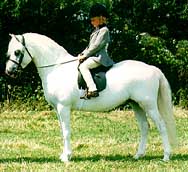Welsh mountain pony (Section A)
N/A
Fri, 11th April, 2025 - 11:24 pm GMT
Sponsor Ads:

Alternative Name
N/ABasic Info
The head of the Mountain Pony should be small, with neat pointed ears, big bold eyes and a wide forehead. The jaw should be clean cut, tapering to a small muzzle; the silhouette may be concave or "dished" but never convex or too straight. The neck should be of a good length and well carried with shoulders sloping back to a clearly defined wither. The limbs must be set square with good flat bone and round dense hooves. The tail set high and gaily carried. Action must be straight both in front and behind, quick and free with hocks well flexed.
Health
N/AHabitat
N/ABehavior
Led by proud stallions, bands of mares and their foals roamed in a semi-wild state, climbing mountains, leaping ravines, and running over rough terrain. This sort of existence insured perpetuation of the breed through only the most hardy of stock. Hence, the development of a pony with a remarkable soundness of body, a tremendous endurance, and a high degree of native intelligence.Origin
Hills and valleys of WalesHistory
The original home of the Welsh Mountain Pony was in the hills and valleys of Wales. It was there before the Romans. Its lot was not an easy one. Winters were severe. Vegetation was sparse. Shelter, most often, was an isolated valley or a clump of bare trees. Yet the Welsh Pony managed not only to survive but also to flourish. The centuries of harsh conditions the Welsh Mountain Pony has endured has ensured the sound constitution, iron hard limbs and great intelligence which, combined with the legendary Welsh temperament, makes the ideal child’s pony of today. They can be seen ridden and driven all over the World – equally at home in the cold of Canada and Sweden or the heat of Africa and Australia.Common Foods
grassSponsor Ads:
The first place in which to look for something is the last place in which you expect to find it. -- Unknown
Welsh mountain pony (Section A)
Coded by: BGID® | ALL RIGHTS RESERVED Copyright © 2000-2025
Disclaimer | Privacy | Report Errors / Contact | Credits








 President of the United States of America - Real Estate mogul, Pageant owner and now one of the most controversial men in political history.
President of the United States of America - Real Estate mogul, Pageant owner and now one of the most controversial men in political history.  Politician, US Vice President and President of the USA - Joseph Robinette Biden Jr.
Politician, US Vice President and President of the USA - Joseph Robinette Biden Jr.  versus
versus  Russia: 'The Evil Empire'? Are they all that bad or is it just the USA trying to portray Russia as bad because they are a world power with land bigger and a society very different from the USA ideal?
Russia: 'The Evil Empire'? Are they all that bad or is it just the USA trying to portray Russia as bad because they are a world power with land bigger and a society very different from the USA ideal?  Global warming has been in and out as the "latest" hot topic for many years. It is, according to modern scientists, the result of man-made industrial pollutants, clearing forested areas, agriculture, etc. But now they are thinking it started way before the Industrial Revolution...
Global warming has been in and out as the "latest" hot topic for many years. It is, according to modern scientists, the result of man-made industrial pollutants, clearing forested areas, agriculture, etc. But now they are thinking it started way before the Industrial Revolution... 
 Corona virus
Corona virus 
 Users with wide screen monitors can benefit from more content on every page.
Users with wide screen monitors can benefit from more content on every page.